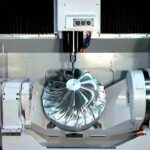
5-Axis Laser cutting has revolutionized manufacturing, offering unparalleled precision and versatility. But what happens when you need to cut complex shapes with intricate angles? That’s where the magic of 5-axis laser cutting comes in. This article will explore the ins and outs of this advanced technology, explaining its benefits, applications, and why it’s becoming increasingly vital in various industries.
5-Axis Laser Cutting:
| Feature | 5-Axis Laser Cutting | Traditional (2-Axis) Laser Cutting |
| Degrees of Freedom | 5 (X, Y, Z, A, B/C) | 2 (X, Y) |
| Cutting Capabilities | Complex 3D shapes, angled cuts, beveled edges, intricate features | Primarily 2D shapes, straight cuts |
| Part Complexity | High | Limited |
| Setup Time | Often reduced due to fewer fixtures | Can require multiple setups for complex parts |
| Accuracy | High, precise cuts | Good, but limited by angle constraints |
| Efficiency | Can be higher for complex parts due to reduced setups and secondary operations | Efficient for simpler 2D cuts |
| Design Freedom | Very high, enables complex designs | Limited to 2D designs |
| Material Waste | Minimal due to precise cutting and optimized paths | Can be higher for complex shapes |
| Cost | Higher initial investment | Lower initial investment |
| Programming Complexity | Requires specialized software and expertise | Simpler programming |
| Applications | Aerospace, automotive, medical devices, manufacturing, art & design, tool & die making | General fabrication, sheet metal cutting, engraving |
| Advantages | Cuts complex 3D shapes, reduces setup time, improves accuracy, enhances efficiency, greater design freedom, minimizes material waste | Lower cost, simpler programming, faster for basic cuts |
| Disadvantages | Higher cost, complex programming, potentially slower for some cuts | Limited to 2D shapes, may require multiple setups, less design freedom |
| Ideal For | Complex parts requiring angled cuts, bevels, or intricate features; low-to-medium volume production | Simple 2D shapes, high-volume production of basic parts |
What is 5-Axis Laser Cutting?
Traditional laser cutting typically involves a laser beam directed perpendicular to the material being cut (known as 2-axis, X and Y). however, adds three more axes of movement: two rotational axes (typically denoted as A and B, or sometimes A and C) and one additional linear axis (Z). These extra degrees of freedom allow the laser head to tilt and rotate, enabling cuts at virtually any angle and orientation. Imagine the laser beam not just cutting straight down, but also angled, pivoting, and even rotating around the workpiece.

How Does it Work?
The 5-axis laser cutting process begins with a 3D model of the part to be manufactured. Sophisticated software then translates this model into precise instructions for the machine. The laser head, guided by these instructions, moves along the X, Y, and Z axes while simultaneously rotating on the A and B (or C) axes. This coordinated movement allows the laser beam to maintain the desired angle and focus relative to the workpiece, even as the shape being cut changes. The result is a clean, accurate cut, regardless of the complexity of the part.
Advantages of 5-Axis Laser Cutting:
- Complex Shapes: The most significant advantage is the ability to cut intricate 3D shapes and features that are impossible with traditional laser cutting. Think of parts with curved edges, beveled edges, or holes at different angles.
- Reduced Setup Time: In many cases, 5-axis laser cutting eliminates the need for multiple setups and fixtures. A single setup can often be used to create complex parts that would otherwise require multiple steps on a traditional machine. This saves time and reduces the risk of errors.
- Improved Accuracy: The ability to precisely control the laser beam’s angle and focus leads to highly accurate cuts with minimal material distortion.
- Enhanced Efficiency: By reducing setup time and minimizing the need for secondary operations, 5-axis laser cutting can significantly improve overall production efficiency.
- Greater Design Freedom: Designers are no longer limited by the constraints of traditional cutting methods. 5-axis laser cutting opens up a world of possibilities for creating innovative and complex designs.
- Minimal Material Waste: The precision of laser cutting, combined with the ability to optimize cutting paths, often results in less material waste compared to other cutting methods.
Applications of 5-Axis Laser Cutting:
5-axis laser cutting is used in a wide range of industries, including:
- Aerospace: Manufacturing complex turbine blades, engine components, and structural parts.
- Automotive: Creating intricate body panels, interior components, and exhaust systems.
- Manufacturing: Producing custom tools, dies, and prototypes.
- Medical Devices: Fabricating precision surgical instruments and implants.
- Art and Design: Creating sculptures, architectural models, and custom art pieces.
- Tool and Die Making: Producing highly accurate and complex dies and molds.
Challenges and Considerations:
While 5-axis laser cutting offers numerous advantages, there are also some challenges to consider:
- Cost: 5-axis laser cutting machines are generally more expensive than traditional laser cutting systems.
- Complexity: Programming and operating 5-axis machines requires specialized expertise.
- Speed: Depending on the complexity of the cut, 5-axis laser cutting can sometimes be slower than other methods. However, this is often offset by the reduction in setup time and secondary operations.
The Future of 5-Axis Laser Cutting:
As technology continues to advance, 5-axis laser cutting is becoming more accessible and affordable. We can expect to see further improvements in speed, accuracy, and ease of use. The integration of automation and robotics will also play a significant role in expanding the applications of this technology.
Conclusion:
5-axis laser cutting is a powerful tool that enables the creation of complex and intricate parts with unparalleled precision. While it may not be suitable for every application, it offers significant advantages in industries where accuracy, efficiency, and design freedom are paramount. As technology continues to evolve, 5-axis laser cutting will likely play an even greater role in shaping the future of manufacturing.



